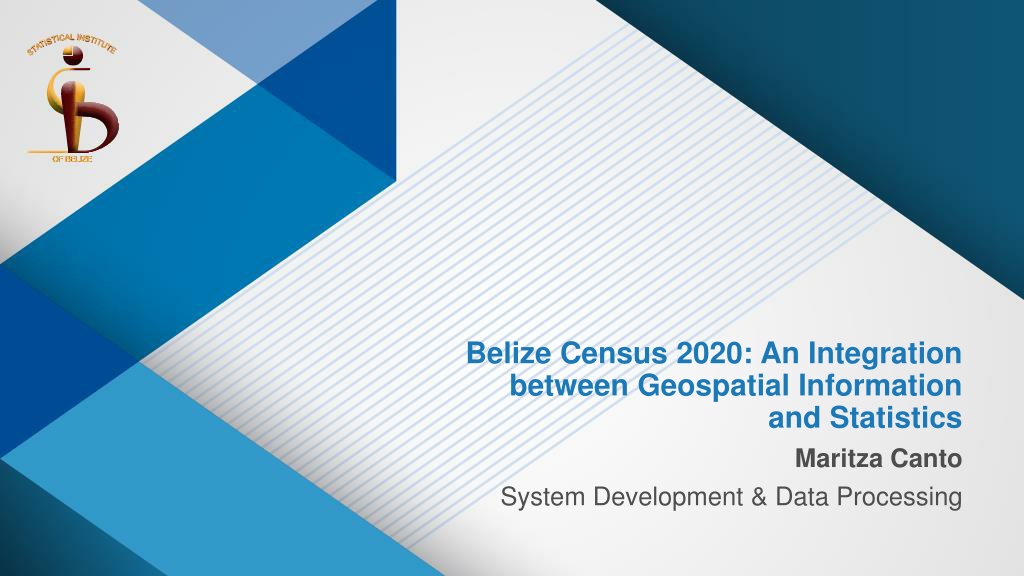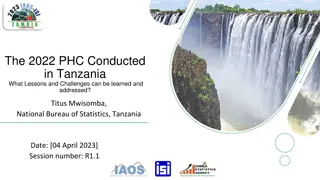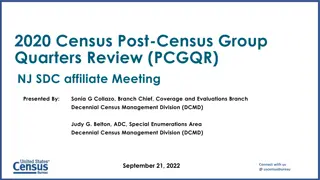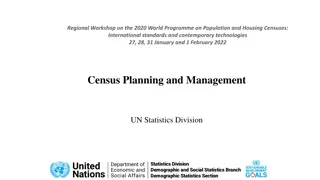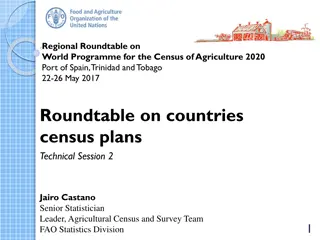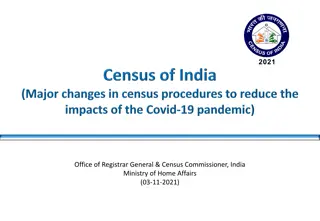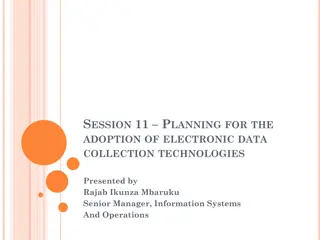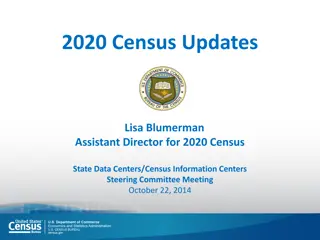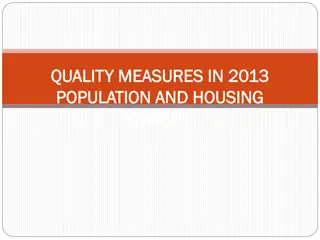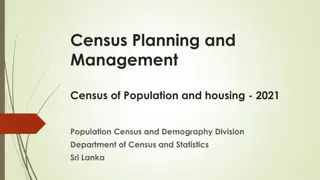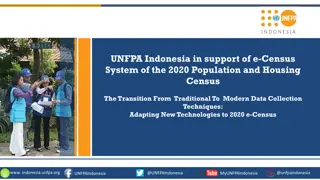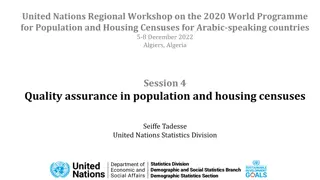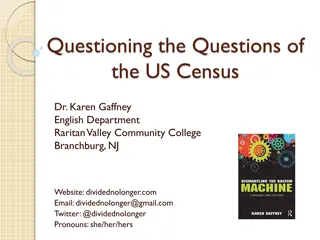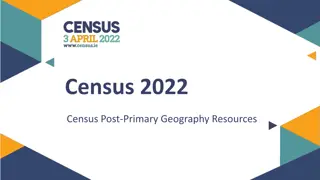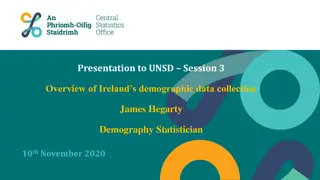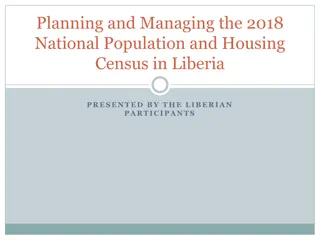Evolution of Census Mapping in Belize
Integration of geospatial information and statistics in the Belize Census of 2020 marked a significant advancement from the methodology used in the 2010 census. The Statistical Institute of Belize (SIB) plays a crucial role in collecting, compiling, analyzing, and disseminating census data. Census mapping supports the pre-enumeration, enumeration, and post-enumeration stages by ensuring map consistency, aiding in data collection, and facilitating the presentation and analysis of census results. The establishment of a GIS unit within the SIB has enhanced the accuracy and effectiveness of census and survey data collection processes.
Download Presentation

Please find below an Image/Link to download the presentation.
The content on the website is provided AS IS for your information and personal use only. It may not be sold, licensed, or shared on other websites without obtaining consent from the author. Download presentation by click this link. If you encounter any issues during the download, it is possible that the publisher has removed the file from their server.
E N D
Presentation Transcript
Belize Census 2020: An Integration between Geospatial Information and Statistics Maritza Canto System Development & Data Processing
Table of Contents Statistical Institute of Belize (SIB) and Census Role of Census Mapping Census Mapping Methodology in 2010 Census Mapping Methodology in 2020 Linking census mapping with Survey Solutions Future Linking of GIS and other statistical data
SIB and Census Census is the most important statistical collection undertaken by SIB Census: Collect, compile, Evaluate, Analyze & Disseminate information Census in Belize has been recorded since December 1816. Census Mapping was introduced in 2010
Role of Census Mapping Pre-Enumeration Ensure map consistency and facilitating census operation Enumeration Supporting data collection stage in order to eliminate overlapping or omission of enumeration areas and also can help to monitor census activities Post-Enumeration Maps makes it easier to present, analyse, and disseminate census results by using spatial analysis techniques for producing statistical thematic maps.
Census Mapping Methodology in 2010 There was only one Geographic Information Officer at SIB Relied on Administrative Data The Census Geographic Structure District Level Units Locality Level Units City Level Units (2) Town Level Units Village Level Units Enumeration Areas (700) (6) (10) (8) (199)
Census Mapping Methodology in 2020 Formation of the GIS Unit at SIB The SIB established the GIS Unit within the System Development & Data Processing Department Function of the GIS unit - Updating the enumeration district spatial database by conducting the census mapping exercise - Assist with the design and implementation of a Master Sample Frame - Increasing the accuracy and effectiveness of census and survey data collection - Building an accurate geo-statistical database
Census Mapping Methodology 2020 Contd Existing base data within SIB - visitation records from recent surveys - Listing exercise data collected in 2017 - Enumeration Boundaries - Building Footprints, Building Points - Road and Rivers Existing base data from other organization - Parcel/Cadastral Data - Administrative Boundaries Country, District - Electoral Divisions
Census Mapping Methodology in 2020 Contd GIS Software and Hardware ArcGIS desktop for Advanced 10.5 ArcGIS Online Trimble TDC (1-2 m) Collector for ArcGIS
Census Mapping Methodology in 2020 SIB GIS Hierarchy Operational Layers Geodatabase Building Footprints Enumeration Districts Points of Interest Blocks Rivers Roads
Pre-enumeration enumeration Post-enumeration | dissemination Enumerator Field Manager ArcGIS for Desktop Analysts Public and Secured Web Maps And/or ArcGIS for Open Data .shp, .kml, .csv | geoJSON, GeoServices | DCAT GIS Analyst Operations Dashboard for ArcGIS Survey Solutions Field Mapping Staff: Assistants Coordinators Supervisors Collector For ArcGIS ArcGIS for Server Web Mapping server: ArcGIS for server, Web Adaptor, Portal for ArcGIS Database server Imagery server: ArcGIS for server + Image extension File server: imagery data ArcGIS Online Content GIS System Administrator Base Map Imagery Enumeration Areas Survey Results GIS Data Manager/DBA
Census Mapping Methodology 2020 Mobile Field Data Collection - Digitize Building Footprint from High Resolution ESRI Satellite Imagery - Digitize Road Network from ESRI Satellite Imagery - Digitize Road Network Assist with Creation of Blocks - Creation of Web Map in ArcGIS Online - Download web map on Collector for ARCGIS Installed on Trimble TDC 100 for offline use - Conduct ground truthing exercise to validate/update building footprint and road network - Collect attribute information (land-use and pictures) of each building footprint - Videos of buildings within a block were taken and pictures extracted and attached to corresponding buildings.
Census Mapping Results Figure 1. Picture Illustrating Building Footprint Data Collected in Dangriga Town
Census Mapping Results Figure 2: Picture Illustrating Collector for ArcGIS Data Collection Form
Linking of Building Footprint with Survey Solutions Enumerator, uses Collector for ArcGIS to Navigate to Buildings in their assigned Enumeration District. Enumerator is in front of the building, he/she will click on the building point or building footprint on the Collector s App map which will show a pop-up box with information. The Pop-up box shows: Building Unique Identifier (BUID) Building Picture Street Name (optional) The Lister/Enumerator copy the BUID and switches to the Survey Solutions CAPI app, opens a survey form and enters the BUID, which is then followed by Dwelling Number and/or Household Number, which then follows questions regarding Census 2020.
Linking of Building Footprint with Survey Solutions BUID Assignment BUID is assigned to Existing Buildings Building are Numbered from 0001 to 99,000, in the order of ten (10), example, 00010, 00020, 00030, 00040, etc. If a new building is encountered, the new building is assigned the increment of one (1), by the previous building encountered, example, 00011, 00021, 00031, 00032, etc. BUID Formation Building Unique ID = (District# - Grid Code - CTV Code Building #) Example: Toledo District #= 6 Grid Code = FEN CTV Code (San Benito Poite) = 50 Building # = 00010 BUID = 6FEN5000010
Future Linking of GIS and Statistical Data Business Register Belize National Statistical System Belize National Spatial Data Infrastructure
Keep in touch http://www.facebook.com/belizestatistics/ Sign up to receive emails of our releases http://www.sib.org.bz/contact-us For more information, visit our website http://www.sib.org.bz
